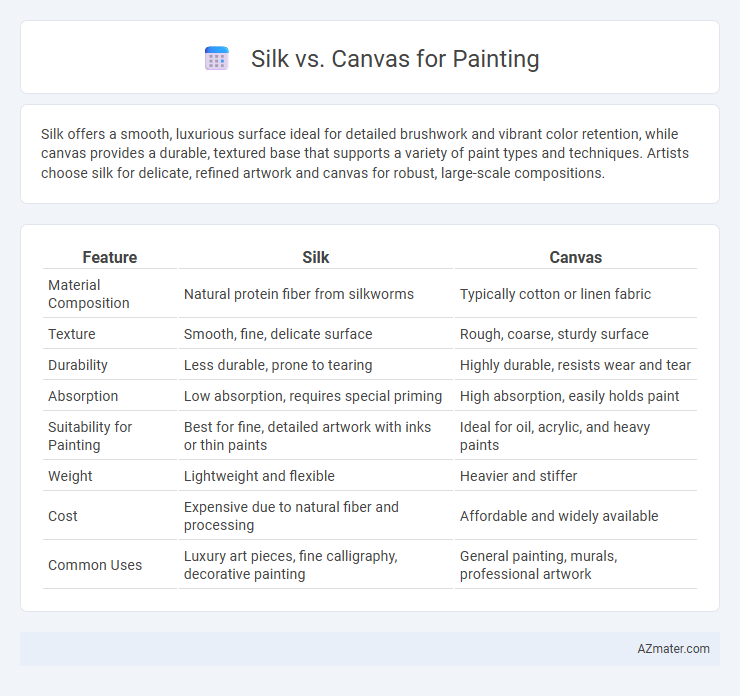Silk offers a smooth, luxurious surface ideal for detailed brushwork and vibrant color retention, while canvas provides a durable, textured base that supports a variety of paint types and techniques. Artists choose silk for delicate, refined artwork and canvas for robust, large-scale compositions.
Table of Comparison
| Feature | Silk | Canvas |
|---|---|---|
| Material Composition | Natural protein fiber from silkworms | Typically cotton or linen fabric |
| Texture | Smooth, fine, delicate surface | Rough, coarse, sturdy surface |
| Durability | Less durable, prone to tearing | Highly durable, resists wear and tear |
| Absorption | Low absorption, requires special priming | High absorption, easily holds paint |
| Suitability for Painting | Best for fine, detailed artwork with inks or thin paints | Ideal for oil, acrylic, and heavy paints |
| Weight | Lightweight and flexible | Heavier and stiffer |
| Cost | Expensive due to natural fiber and processing | Affordable and widely available |
| Common Uses | Luxury art pieces, fine calligraphy, decorative painting | General painting, murals, professional artwork |
Introduction to Silk and Canvas in Painting
Silk, a natural protein fiber known for its smooth texture and luminous sheen, offers artists a unique surface that enhances the vibrancy and delicacy of paint, especially in fine detail and traditional Asian artworks. Canvas, typically made from cotton or linen, provides a durable, textured surface favored for its strength and ability to absorb paint evenly, making it ideal for a wide range of styles from oil to acrylic painting. Both materials influence paint application and finish, with silk excelling in translucency and fine detail, while canvas supports bold, textured brushwork and longevity.
Historical Use of Silk and Canvas
Silk has been historically favored in Asian art, especially in Chinese and Japanese painting, for its smooth texture and ability to hold detailed brushwork, dating back over a thousand years. Canvas gained prominence in Europe during the Renaissance as a more durable and economical alternative to wood panels, revolutionizing oil painting techniques. Both materials have distinct historical roles, with silk emphasizing fine, intricate imagery and canvas supporting larger, more textured works.
Material Properties: Silk vs Canvas
Silk exhibits a smooth, fine texture with natural sheen, making it ideal for delicate, detailed paintings requiring brilliance and subtle color gradation. Canvas, typically made from cotton or linen, offers a sturdy, coarse surface that enhances texture and durability, suitable for heavy-bodied paints like oil and acrylic. While silk requires a specialized approach due to its absorbency and delicateness, canvas provides versatility and long-lasting support for various painting techniques.
Texture and Surface Differences
Silk offers a smooth, fine texture with a natural sheen that enhances the vibrancy of paint, making it ideal for detailed, delicate artwork. Canvas features a coarser, textured surface with pronounced weave patterns, providing better grip for thicker paints and bold brushstrokes. The choice between silk and canvas significantly affects the paint absorption and the tactile quality of the finished piece.
Paint Compatibility and Techniques
Silk offers a smooth, delicate surface ideal for watercolor, gouache, and ink, allowing vibrant colors to flow and blend seamlessly, while canvas provides a textured, porous base suited for oil and acrylic paints, enhancing adhesion and durability. Techniques such as fine brushwork and glazing excel on silk due to its gentle absorbency, whereas impasto and heavy layering are better executed on canvas thanks to its sturdy weave. Understanding paint compatibility ensures optimal application, with silk demanding careful handling and specialized primers, whereas canvas supports a broader range of media and heavy textural effects.
Durability and Longevity Comparison
Canvas offers superior durability compared to silk, making it the preferred choice for long-lasting paintings due to its robust, tightly woven cotton or linen fibers. Silk, while providing a smooth, luxurious surface ideal for fine detail, is more delicate and susceptible to environmental damage such as humidity and light exposure, reducing its longevity. Conservation specialists often recommend canvas for artworks intended to endure over time, as silk requires more careful maintenance to preserve its integrity and color vibrancy.
Aesthetic Outcomes on Silk vs Canvas
Silk produces luminous, vibrant colors with a smooth, reflective surface that enhances fine detailing and creates a luxurious aesthetic quality in paintings. Canvas offers a textured, matte finish that excels in absorbing pigments, providing depth and richness with a more traditional, tactile appeal. Artists seeking intricate highlights and delicate brushwork often prefer silk, while those favoring bold strokes and dynamic textures typically choose canvas.
Suitability for Different Painting Styles
Silk offers a smooth, delicate surface ideal for detailed watercolor and traditional Asian brush painting, enhancing fine lines and subtle color gradients. Canvas provides a textured, durable foundation better suited for acrylic and oil painting, supporting bold brushstrokes and heavy paint layering. Artists select silk for precision and softness in style, while canvas matches expressive, textured techniques.
Cost and Accessibility Considerations
Silk painting supplies tend to be more expensive due to the delicate nature of silk fabric and specialized dyes, making it a less accessible option for beginners or budget-conscious artists. Canvas materials are generally more affordable and widely available across various art supply stores, offering greater accessibility for artists at all skill levels. Cost-effective canvas options, combined with its durability, make it a preferred choice for those seeking affordable and easily obtainable painting surfaces.
Choosing the Right Medium for Your Art
Silk offers a smooth, luxurious surface ideal for fine detail and vibrant color saturation in painting, while canvas provides a durable, textured foundation suited for bold strokes and heavier applications. Artists seeking longevity and versatility often choose canvas for its resistance to wear and ease of framing, whereas silk suits delicate projects requiring finesse and luminance. Selecting the right medium depends on the desired artistic effect, texture preference, and the painting's intended display or preservation conditions.

Infographic: Silk vs Canvas for Painting
 azmater.com
azmater.com